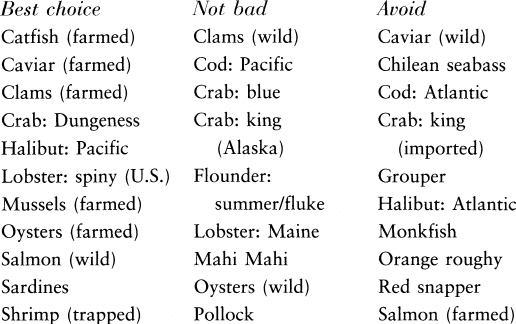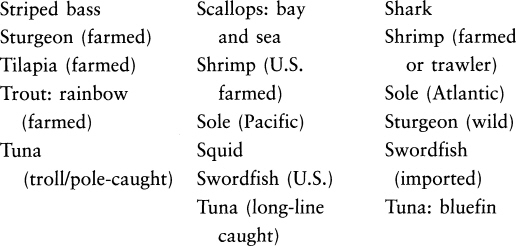Real Food (16 page)
Authors: Nina Planck

*Two studies were conducted in the United States.
Source: Andrew Stoll,
The Omega-3 Connection.
In children, omega-3 fat deficiency is linked to dyslexia, poor motor skills, and attention deficit hyperactivity disorder.
13
Deficient teenagers and adults are prone to anger, hostility, and violence. Pregnant and nursing women who don't replenish
omega-3 stores face serious risk of postnatal depression.
14
(Omega-3 fat depletion is cumulative; that is, if the mother's diet lacks these essential fats, deficiency grows with each
pregnancy and each generation.) In older people, lack of omega-3 fats is linked to Alzheimer's disease and dementia.
Fish oil prevents depression in several ways. Omega-3 fats make up nerve cell membranes, which affect the transmission of
nervous system signals. ALA, DHA, and EPA regulate calcium, sodium, and potassium ions, which control electrical activity
in the brain. Omega-3 fats directly activate receptors for neurotransmitters including dopamine and serotonin, chemical messengers
for mood, sleep, appetite, and libido— symptoms altered or crippled by depression. Finally, eicosanoids have a vital (though
poorly understood) effect on mood.
Schizophrenia is one of the more distressing and intractable mental illnesses. The traditional treatment, which is more than
fifty years old, employs drugs to alter levels of dopamine and serotonin. This works for about 30 percent of patients— not
impressive. Moreover, the drugs are costly and cause side effects. A radical new approach begins with the observation— first
suggested by Dr. David Horrobin in the 1970s— that the brain is made of fat.
15
Neurotransmitters are carried in pouches made of fats called phospholipids, which the body can make from plant-based sources
of omega-3 fats or (ideally) obtain directly from fish. In the schizophrenic brain, however, the complex metabolism of fatty
acids is damaged, so that neurons and neurotransmitters don't work properly. Early clinical trials suggest that fish oil supplements
might be as effective as drugs, without the side effects.
16
If fish oil can prevent or treat obesity, diabetes, heart disease, and depression, the muscular salmon immortalized by CroMagnon
artists begins to look like a delicacy, superfood, and wonder drug, all wrapped up in one speckled silver package. Clearly,
eating fish is a good thing. If only deciding
which
fish to eat were as simple.
FISHING is FUN, but— famously— it involves a fair bit of waiting around for the fish to fall into the trap, whether it's a
net, basket, or hook. If you fish for fun, simply watching the water rush by is pleasant enough, but it would quickly seem
inefficient if dinner depended on it. One day, a clever
Homo piscator
(his brain swollen by omega-3 fats) began to wonder whether there wasn't a quicker, more reliable way to gather the tasty
protein he was now accustomed to eating every day. His idea was to trap, feed, and breed fish. In Asia, carp farming is an
ancient form of agriculture; the book
Fish Culture Classics
was printed in 460 BC.
Alas, traditional fish farming is all but forgotten. The marine equivalent of cattle feedlots, confinement dairies, and battery
egg farms, fish feedlots present the all-too-familiar problems of intensive food production: crowding, disease, parasites,
pesticides, antibiotics, excess manure, environmental damage, and— did you guess?— less nutritious food. Just as beef, milk,
and eggs raised on grass contain more omega-3 fats than those fed grain and soybeans, wild fish contains more omega-3 fats
than farmed fish.
These undesirable effects were little known in the 1970s, when the Norwegians pioneered salmon farming. Quickly taken up by
Scotland, Chile, and Canada (all countries blessed with long, indented coastlines), fish farming was an immediate hit. "By
the late 1980s, salmon had gone from being a luxury fish to an absolute steal," writes Gina Mallet in
Last Chance to Eat.
No doubt that seemed like progress, but the effects on salmon, the sea ecology, and nutrition were less savory.
WILD FISH BETTER THAN FEEDLOT FISH

Source: Artemis P. Simopoulos, "Omega-3 Fatty Acids in Health and Disease and in Growth and Development."
American Journal of Clinical Nutrition,
Vol 54 (1991): pp. 438-63.
The insults start at birth. To stock fish feedlots, female and male salmon are anesthetized before farmers squeeze out their
eggs and sperm. Like the animals on factory farms, farmed salmon is fattier than wild fish— by design. The feedlot diet of
fish meal and growth-promoting antibiotics is deliberately fattening. Wild fish also get a lot more exercise, which produces
firm, well-toned flesh, not the flabby, greasier version found in feedlot fish.
Wild salmon is measurably cleaner than feedlot fish. In 2004,
Science
published research showing that farmed salmon contains "significantly" more toxins, including PCBs and dioxin, than wild fish.
Similar problems occur in other farmed seafoods. Imported farmed shrimp may contain the drug chloramphenicol. This potent
antibiotic drug is used in therapeutic doses for treating serious infections in humans. The United States does not permit
chloramphenicol to be used on animals or in animal feed.
Thanks to its natural diet of shrimp, wild salmon is a rich pink color. The species called sockeye is the richest in the carotenoid
astaxanthin, a powerful antioxidant. Feedlot salmon, however, is naturally gray. To give farmed salmon the hue we crave, fish
farmers rely on a dye called canntaxanthin. "The color is chosen from Salmofan," says Mallet, "a color swatch from the chemical
giant Hoffman-La Roche."
It was first thought that aquaculture would protect wild fish, but it turned out to be the other way around. Today more than
half the world's salmon is farmed, and the majestic species known as Atlantic salmon is hanging by a thread. In the icy waters
of Alaska, on the other hand, where salmon farming is banned, the result is a world-famous, thriving wild salmon fishery.
Crowded industrial fish are more susceptible to parasitic sea lice, which (despite routine pesticides) easily spread to wild
fish. Each year, millions of salmon escape from feedlots and breed with wild fish, reducing genetic diversity.
Fish farming also causes collateral ecological damage. Feedlots produce chemical runoff from antibiotics, pesticides, and
detergents, and tons of fish feces, too much to be cleared by ocean currents. In Asia, Latin America, and Africa, shrimp farming
is destroying the complex and vital ecosystem found in mangrove swamps.
The industry defends fish farming as a source of cheap, high-quality protein. However, like other industrial crops, fish feedlots
represent a net
loss
of energy. About three pounds of wild fish are consumed to produce one pound of farmed salmon or shrimp. In
Against the Grain,
Richard Manning describes the unfortunate logic of the industrial fish food chain.
The protein that supports this practice comes from what we call "trash" fish, such as sardines and herring . . . Many of these
species, however, are not trash at all, but a key link in the ocean's food chain and an important part of local fisheries
and diets in the developing world. Left to their own devices, wild fish ( especially salmon) eat the fish that factory trawlers
are now scooping up and
grinding into
fish meal to feed to farmed fish. Absent the trawlers, local fishers in skiffs . . . would catch a few anchovies to feed local
protein-starved communities. Instead, this protein is sucked up, reduced by a factor of three, and shipped to Red Lobsters
across suburban America.
The fish we
should
farm are herbivores (carp, catfish, tilapia) and mollusks (oysters, mussels). But there is money in the carnivores (cod, salmon,
shrimp, tuna). Happily, there are a few environmentally sound alternatives to industrial fish farms. Scotland and Ireland
raise organic salmon without antibiotics and pesticides; they use lower stocking densities, organic feed, and a natural pink
dye, typically made from ground-up shrimp. Scotland also offers sustainable farmed cod, and shrimp from Ecuador are certified
organic by Naturland.
ECO-FRIENDLY FISH AND SEAFOOD
Conservation organizations, including the Blue Ocean Institute and the Audubon Society, rate fish and seafood by its abundance
and the ecological impact of fishing methods. Find current editions of this guide from the Monterey Bay Aquarium at www.seafoodwatch.org.


Most American wild salmon comes from the Pacific. The premier species is sockeye, whose rich ruby color signals high levels
of the natural antioxidant astaxanthin, but some people prefer the milder and richer king salmon. From the Lower Fraser River
in Washington State comes the marble chinook, the only really regionally distinct species, which is caught by hook and line
or trolling, often by Makah and Nootka tribes. The best-quality fish is frozen on the boat, ideally before rigor mortis— when
enzymes begin to break down the flesh— sets in. Fish "frozen at sea" is regarded by people in the know as superior to never-frozen
fish— unless, of course, you live near water and your fish goes straight from the sea to the skillet.
Here in New York City, I often buy local seafood, but I also cook wild Alaskan salmon from small independent boats, a choice
I regard as socially and environmentally sound. It is certainly preferable to any farmed salmon. My red sockeye come from
the
Tommyknocker,
the boat of Rosemary McGuire, who fishes Alaska's famous Copper River Flats. Filets and steaks arrive frozen in vacuum packs
and taste of the sea. The hot smoked salmon in jars is exquisite. I also love wild Alaskan sablefish. Sometimes called black
cod or butterfish, you often see it smoked, in Jewish delis. Ivory and flaky, sablefish has a buttery texture, delightful
flavor, and 50 percent more omega-3 fats than salmon. Filets frozen at sea are superb, but for every day, I eat a lot of canned
wild salmon, which is not expensive.
It's sensible to eat fatty fish two or three times a week— and when you do, be generous with the butter and cream. Saturated
fats extend the body's supply of omega-3 fats; hence classics like Dover sole with butter sauce, lobster claws dipped in melted
butter, and creamy clam chowder. Cold-water, oily fish (mackerel, herring, bluefish, salmon, tuna) have the most omega-3 fats.
A 3.5-ounce (100 gram) portion of sockeye salmon contains more than 1,200 milligrams of DHA and EPA. Sardines— a catch-all
term for any young fish, often herring— contain 500 percent more omega-3 fats than tuna.
A word of caution about wild fish, however. Mercury is an environmental pollutant known to cause brain damage. Like other
metals, mercury accumulates in tissue as it moves up the food chain, which means larger, carnivorous fish contain more mercury
than smaller ones. Thus the FDA advises children and pregnant women not to eat swordfish, shark, king mackerel, or tilefish.
But it's unwise to avoid fish altogether.